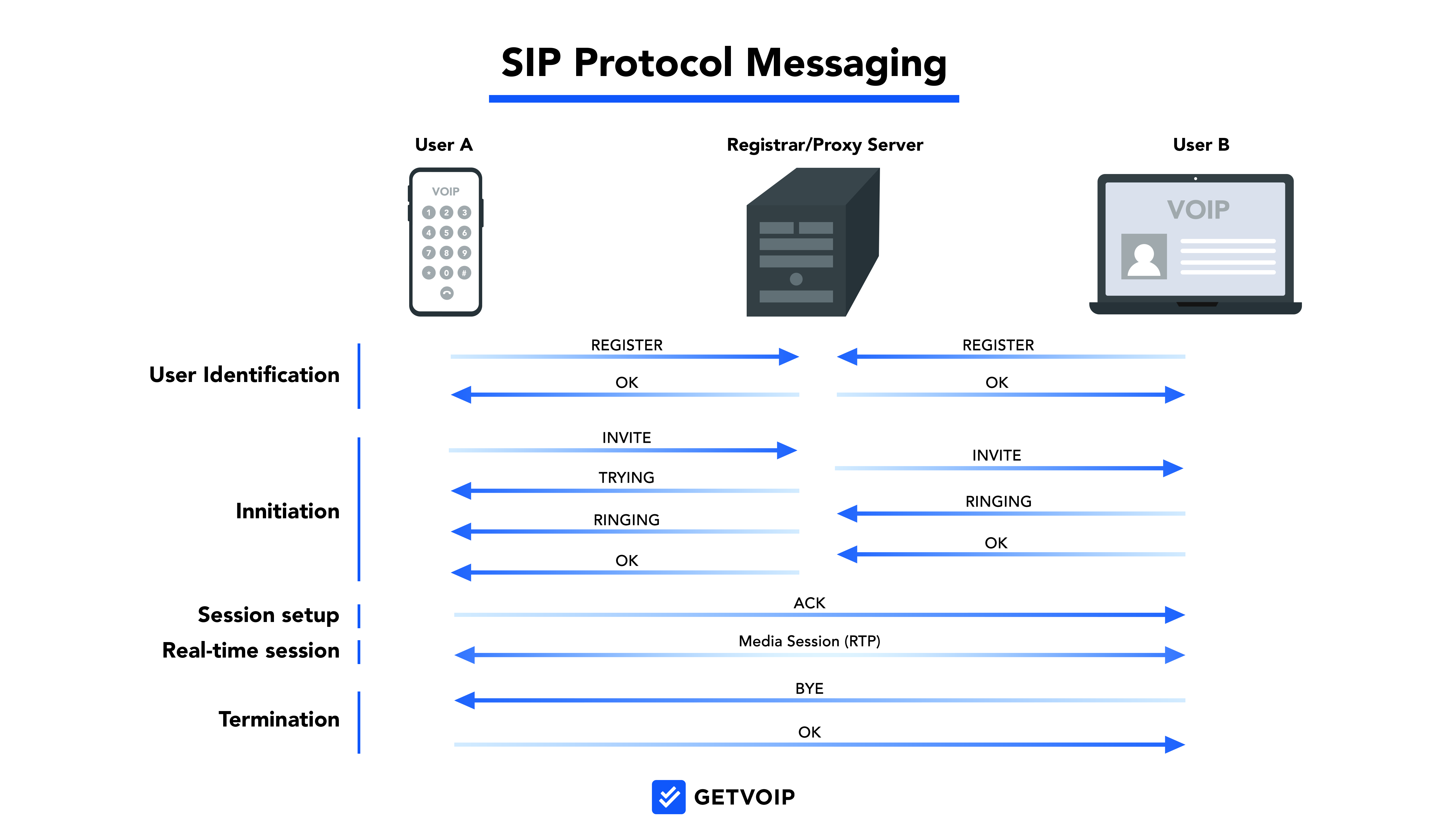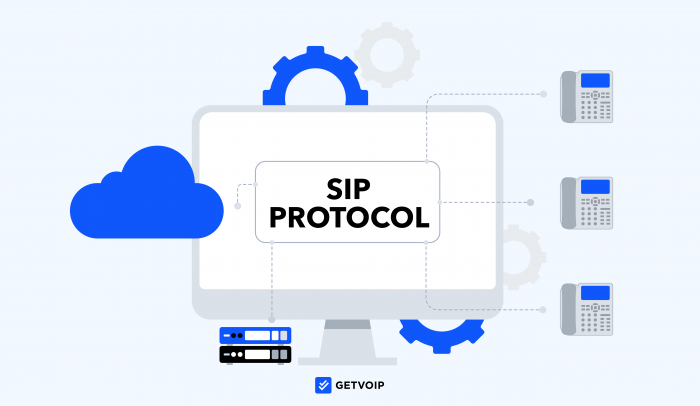The SIP Protocol plays a major role in today’s real-time media communications, including video conferencing, VoIP telephony, instant messaging, and more. SIP enables thousands of telecommunications apps, powering tools like call center software and cloud-based phone systems.
This article will outline the SIP Protocol, discussing how it works, where it’s used, its benefits and drawbacks, and how to choose a SIP provider.
- What is SIP?
- How SIP Works
- Features and Capabilities
- Where is SIP used?
- SIP Trunking
- SIP vs VoIP
- SIP Benefits
- SIP Limitations
- Choosing a SIP Provider
- FAQs
What is Session Initiation Protocol (SIP)?
Session Initiation Protocol (SIP) is a signaling protocol that establishes, maintains, and terminates real-time media communication sessions between two or more parties. SIP outlines data processing and formatting rules that synchronize computers to establish a direct media session for voice, audio, or messaging communications. SIP enables popular communication technologies like business Voice over IP (VoIP), video conferencing, voice over LTE (VoLTE), instant messaging, and other unified communications services.
How Does SIP Protocol Work?
SIP Protocol defines the format and sequence of backend messages that computers use to coordinate and initiate real-time media communications. The protocol outlines rules that disparate software systems follow to synchronize various aspects of the media call: media streams involved, invitations to each party, each user's IP address, the ports that will be used, the media codecs that will be used, and data message formatting.
Put simply, SIP guides computer systems to synchronize their technology and establish direct media communications–voice or video calls over the Internet. SIP achieves this through a series of backend messages each user’s software sends to other parties involved. These messages contain information and data that establishes the call.
SIP handles the following media functions:
- Registers users and locations: SIP messages carry information about each user’s IP address and identity, which registers and authenticates users before connecting them on a call
- Invites users: One user sends a SIP message inviting other parties for a VoIP or video call, thereby initiating a real-time connection
- Specifies formatting details: SIP messages enable users, or endpoints, to coordinate important formatting details–which codecs participants will use, active media streams the call will use, and which protocols will carry the media. Typically, SIP sessions utilize real-time transport protocol (RTP) or secure real-time transport protocol (SRTP) to transmit media.
- Confirms receipt and initiates the session: SIP provides receipts confirming that users have received and responded to messages, getting everyone on the same page to initiate the session
- Terminates session: Similar to how SIP requests invite users, they also communicate termination to each user when the media session ends
SIP works alongside other application-layer protocols that handle other aspects of real-time media communication. For example, some SIP messages contain Session Description Protocol (SDP) data that coordinates parameters for the meeting. Once SIP establishes a media session, RTP or SRTP transmits the audio and video data.

SIP Uses Requests, Messages, and Responses
When a user initiates a SIP application, their device sends a request to the SIP server, which forwards the request to the recipient’s SIP server, which then forwards the message to the recipient’s device. Whenever a request reaches a server, the software sends a receipt back to the sender. This back-and-forth communication occurs in nanoseconds between all parties involved in the call.
Each party using SIP acts as a request sender and responder, respectively called a client and recipient.
SIP Protocol Features and Capabilities
Using client-server architecture, the SIP Protocol guides software systems to coordinate, initiate, and terminate real-time media sessions–including VoIP calls, video conferencing, messaging, and other UCaaS communications.
Each request from a SIP client asks for a service from SIP servers, and each server message contains data or information that allows software programs to coordinate information for the media session. Through this back-and-forth communication, SIP synchronizes software to initiate a VoIP call.
SIP Protocol Features
The SIP Protocol relies on the communication between several network elements: User devices or “endpoints,” wireless network connectivity, proxy servers, and registrars.
- User devices: Also called “endpoints,” user devices typically install software that uses SIP to send requests and communicate with other users’ software. SIP devices include computers, mobile phones and smartphones, tablets, or hardware VoIP phones–which connect to the Internet and run SIP-based applications like VoIP phone systems, video meeting software, UCaaS platforms, and instant messaging interfaces.
- Network connectivity: SIP software requires an internet connection, at the local area network (LAN) and wide area network (WAN) levels, to transmit requests and data between clients and servers
- Proxy servers: Proxy servers receive requests from user endpoints and forward the requests to the recipient’s server or device. Proxy servers can forward messages and requests to multiple endpoints, enabling one user to send data to many other users on a multiparty SIP call.
- Registrar servers: Registrar servers, part of SIP software installed on a device, receive REGISTER requests from user devices and share this information with other users in the media session. This authenticates users for the interaction and enables other protocols, such as RTP, to send data directly to each involved user’s endpoint during real-time media communications.
SIP Capabilities
The protocols outlined above enable SIP software systems like VoIP to communicate via service requests and messages, transmitting data between each other. This process provides the basis for all SIP communications. Therefore, SIP requests and messages form the basis for all SIP capabilities.
There are 14 total SIP requests, but these 10 are the most important:
- REGISTER: Identify each user’s address, to authenticate users and ensure other protocols know where to send media data
- INVITE: Initiates the SIP call and the media session
- ACK: A response message confirming that the other party has received the sender’s message
- BYE: Terminates the session
- CANCEL: Cancels a request that hasn’t been completed yet
- UPDATE: Modifies a media session
- REFER: Facilitates a call transfer
- SUBSCRIBE: Subscribes a user to receive notification data from a notifying party, such as a video conference host
- NOTIFY: The notifier can inform subscribers about changes or events
- MESSAGE: Sends a text message, such as an SMS or instant message
These requests enable SIP communication capabilities:
- User authentication and registration
- Inviting all users to the SIP session
- Determining which codecs and media stream protocols the session will use
- Making adjustments to the session when necessary
- Sending text and chat messages during the session
- Transferring calls to different users
- Notifying users about software or streaming updates during the session
- Ending the session
Where is SIP Used?
SIP establishes real-time media communications including voice, video, and messaging. Therefore, SIP is used for a variety of unified communications purposes:
- VoIP: SIP establishes audio calls over the internet and therefore plays a role in VoIP calls. Cloud-based phone systems, call centers, and UCaaS platforms like RingCentral and Nextiva utilize SIP to initiate and connect calls over the web.
- Voice over LTE (VoLTE): VoLTE uses SIP to register user, authenticate their addresses, and establish calls over cellular networks
- SIP trunking: SIP trunking is when a company sets up a session border controller to connect a virtual phone system to their PSTN landline system, thus integrating VoIP functionality. While the session border controller is a physical piece of hardware, the SIP server that enables SIP on users’ devices can be a piece of physical equipment or cloud-hosted software.
- Video conferencing: SIP establishes real-time video communications over the internet, enabling audio and video components of the call. Video conferencing software like Zoom and Skype, and browser-based video technologies like WebRTC can utilize SIP to initiate sessions between parties.
- Instant messaging: SIP uses MESSAGE requests to facilitate instant messaging between users, as a standalone chat app or embedded chat box on a video call. Just like with video and audio, SIP authenticates users. SIP also provides read receipts and indicates when users are actively typing.
- SMS texting: SMS text messages can use the SIP MESSAGE request to transmit texts between users
- Presence detection: SIP messages can convey a user’s presence status, such as Active, Idle, Busy, or Away
What is SIP Trunking?
SIP trunking is when a company connects a virtual phone system to its onsite PSTN system, thus integrating VoIP functionality with landline. To set up SIP trunking, a business usually purchases a session border controller–a device that controls data flow between virtual phone systems and landline. Next, the business subscribes to a VoIP service provider, who provides VoIP via a hardware or software-based SIP server.
With the session border controller and SIP server connected, the company has an on-premise VoIP phone system capable of making calls via the Internet and landline PSTN.
SIP vs. VoIP
Voice over the Internet Protocol (VoIP) is the technology of making calls over the Internet, while Session Initiation Protocol (SIP) is a protocol that initiates real-time media sessions like VoIP. The two protocols work together, with SIP establishing VoIP calls.
SIP is just one of the protocols that VoIP uses to facilitate a call, along with SIP’s partner protocols like Real-Time Transport Protocol (RTP), Session Description Protocol (SDP), and Media Gateway Control Protocol (MGCP). However, SIP isn’t the only signaling protocol that initiates and terminates VoIP calls. VoIP software can also use other protocols, like H.323 or Asterisk, to connect calls over the Internet. SIP is just one way of initiating and terminating VoIP sessions.
For a further breakdown of SIP vs. VoIP, check out our detailed comparison of these technologies.
Benefits of Using SIP for Communication
Compared to landline phone systems and other communications protocols like H.323, SIP offers several key benefits:
- Cost-effective: SIP applications, like UCaaS platforms and VoIP phone systems, often cost under $25 monthly per user and provide strong communication capabilities
- Low maintenance: While SIP trunking and onsite PBX systems require that your technical team maintain the session border controller or PBX, most SIP-based platforms are hosted virtually by the provider. This requires virtually no maintenance or technical expertise from the end user.
- Easy setup: To install a hosted SIP-based phone system, simply download the app from your service provider. Whether the app is a video conferencing platform, VoIP phone system, or a UCaaS platform, users can download the app, install it, and begin using the service within minutes.
- Advanced phone system features: SIP-based VoIP applications typically provide dozens of business-phone features like multi-level IVR menus, call queueing, comprehensive user dashboards, call monitoring, and analytics
- Multiple communication channels: Unified communications apps–like Dialpad, Zoom One, and GoTo Connect–use SIP to initiate multiple business channels such as voice, video, and team chat. UCaaS apps provide businesses with multiple ways to communicate with customers or internally.
- Scalability and remote access: Since SIP can be embedded into cloud-hosted software, businesses can provision communications apps for team members based anywhere. SIP solutions make it easy for teams to add and remove users, including remote staff.
- Accessibility across devices: Users can access SIP-based software through a variety of devices–desktops and laptops, cell phones, or VoIP phones
Challenges and Limitations of SIP Protocol
While SIP provides plenty of communication benefits, it has a few limitations:
- Requires sufficient bandwidth: Real-time media communications involving SIP, such as VoIP calls or video meetings, require an ongoing back-and-forth data flow between all users. This process demands a large amount of available bandwidth on local networks, which limits the number of concurrent SIP users a single router can support.
- SIP trunking and onsite PBX require maintenance: While hosted SIP platforms are low maintenance, on-premise SIP architecture like SIP trunking and on-premises PBX systems require a knowledgeable IT staff
- Security vulnerabilities: SIP media streams are generally secure and encrypted, but sometimes attackers can intercept data or join SIP calls as an unauthorized user
How to Choose a SIP Provider
To choose the best SIP provider and software for your company, use the following three steps:
- Consider which communication channels you want
- Decide between hosted and on-premise architecture
- Compare software features and pricing
1. Consider Which Communication Channels You Want
Since SIP providers and software offer several different software solutions–including VoIP platforms, UCaaS software, and video meeting tools–it’s important to first choose which channels your company wants. Take inventory of which channels you already have, noting if your current phone system is landline-based or cloud-based.
Keep in mind that you can choose a platform that specializes in one particular channel–such as VoIP or video software–or you can choose a unified communications solution that combines channels. You can opt for basically any combination of communication channels that your business needs.
2. Decide Between Hosted and On-Premise Architecture
Especially for VoIP, you can choose between subscribing to a cloud-hosted SIP architecture or hosting your SIP platform onsite–with a setup like SIP trunking or an on-premise virtual PBX.
Hosted SIP solutions are much more convenient and low-maintenance since they require no extra hardware. Users simply download the software and can instantly access all the communications features in a dashboard accessible across devices. This architecture is generally inexpensive, as many providers offer multiple tiers of pricing plans. Even the low tiers come with a surprising breadth of features. Hosted VoIP and SIP software is a good option for remote and hybrid teams.
On-premise SIP architecture works well for in-person teams that already utilize the PSTN landline as a phone system. This architecture requires that you install and maintain the hardware, including servers, VoIP phones, and a session border controller. Generally, on-premise SIP is more of a hassle to maintain and can be costly.
3. Compare Software Features and Pricing
Once you’ve decided which channels and architecture you want, compare various software solutions. For each provider you examine, note the pricing tiers they offer and the features included in each pricing tier.
Aim to compare at least five providers, to get a feel for how pricing corresponds to features within each pricing tier. Of course, pricing will vary according to which type of software you want. Call center software tends to be the most expensive due to its advanced monitoring features, UCaaS platforms are somewhat pricy because they include communication channels, and single-channel platforms like VoIP solutions and video-conferencing platforms are usually the cheapest.
However, each provider and pricing tier offers a unique suite of features. Try to find the provider and pricing tier that offer the most features your company will use, while still meeting your communication budget.



